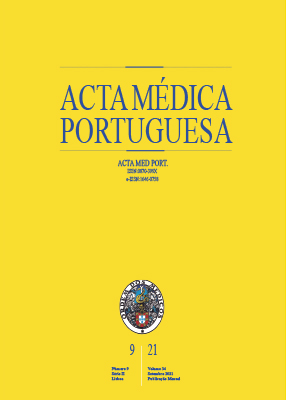MYOC Gene Sequencing Analysis in Primary Open-Angle Glaucoma Patients from the Centre Region of Portugal
DOI:
https://doi.org/10.20344/amp.14922Keywords:
Glaucoma diagnostic, Late-onset Glaucoma, Missense mutation, MYOC gene, Normal Tension GlaucomaAbstract
Introduction: Primary open-angle glaucoma is the most frequent subtype of glaucoma. Relatives of primary open-angle glaucoma patients have an increased risk of developing the disease, suggesting a genetic predisposition to the disease. MYOC was the first primary open-angle glaucoma-causing gene identified. This study aimed to identify sequence variations in the MYOC gene that may be responsible for the phenotype in a group of primary open-angle glaucoma patients from the Centre Region of Portugal.
Material and Methods: The three coding exons and the proximal splicing junctions of the MYOC gene were studied using a PCR sequencing approach in a group of 99 primary open-angle glaucoma patients.
Results: The sequencing analysis enabled the identification of 20 variants, including four in the promoter region, seven in the introns and nine in exons one and three, of which four were missense variants.
Discussion: Initially, all four missense sequence variations identified were considered candidates to glaucoma causing disease mutations. However, after literature review, only variant c.1334C>T (Ala445Val) remained as likely responsible for mild late-onset normal tension glaucoma.
Conclusion: This is the first study performed in a group of primary open-angle glaucoma patients from the Centre Region of Portugal, contributing to the identification of one genetic variant in the MYOC gene and reinforcing the hypothesis that normal tension glaucoma could be also due to MYOC gene mutations.
Downloads
Downloads
Published
How to Cite
Issue
Section
License
All the articles published in the AMP are open access and comply with the requirements of funding agencies or academic institutions. The AMP is governed by the terms of the Creative Commons ‘Attribution – Non-Commercial Use - (CC-BY-NC)’ license, regarding the use by third parties.
It is the author’s responsibility to obtain approval for the reproduction of figures, tables, etc. from other publications.
Upon acceptance of an article for publication, the authors will be asked to complete the ICMJE “Copyright Liability and Copyright Sharing Statement “(http://www.actamedicaportuguesa.com/info/AMP-NormasPublicacao.pdf) and the “Declaration of Potential Conflicts of Interest” (http:// www.icmje.org/conflicts-of-interest). An e-mail will be sent to the corresponding author to acknowledge receipt of the manuscript.
After publication, the authors are authorised to make their articles available in repositories of their institutions of origin, as long as they always mention where they were published and according to the Creative Commons license.









